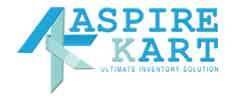Description

Delta Inventory

Enspire Commerce
Comprehensive Overview: Delta Inventory vs Enspire Commerce
Delta Inventory and Enspire Commerce are solutions designed to address inventory management and broader commerce challenges for businesses, although they serve different functions and target somewhat overlapping markets. Below is an overview of each product, including their primary functions, target markets, market share insights, user base, and key differentiating factors.
a) Primary Functions and Target Markets
Delta Inventory:
-
Primary Functions:
- Provides inventory management solutions that help businesses track inventory levels, orders, sales, and deliveries.
- Features include real-time inventory visibility, demand forecasting, replenishment, multi-location inventory tracking, and reporting.
- Emphasizes efficiency and accuracy in inventory management processes to reduce overstock and stockouts.
-
Target Markets:
- Primarily targets small to medium-sized retailers, e-commerce businesses, and distributors that need efficient inventory management solutions.
- It may also cater to larger enterprises that require specific inventory control features integrated within a larger supply chain management system.
Enspire Commerce:
-
Primary Functions:
- Offers a unified commerce platform that includes order management, inventory management, POS integration, and customer service capabilities.
- Provides tools for omnichannel retailing, allowing businesses to manage sales across multiple channels such as in-store, online, and mobile platforms.
- Emphasizes seamless customer experiences and streamlined operations across various sales channels.
-
Target Markets:
- Targets medium to large retailers and omnichannel businesses that operate across multiple sales channels and need to integrate their operations into a single platform.
- Often appeals to companies looking for robust, end-to-end solutions that cover a wider range of commerce functionalities beyond inventory alone.
b) Market Share and User Base
-
Market Share:
- Delta Inventory typically serves a niche segment focused predominantly on inventory-specific solutions. As a more specialized tool, its market share is smaller compared to broader platforms like Enspire Commerce.
- Enspire Commerce, being part of a larger suite that handles multiple aspects of a business, tends to have a broader market presence, especially among retailers seeking full-fledged commerce solutions.
-
User Base:
- Delta Inventory is most popular among small to medium-sized enterprises (SMEs) who require cost-effective and simple inventory management solutions.
- Enspire Commerce attracts larger businesses or rapidly growing SMEs looking for comprehensive commerce capabilities, sometimes including those that look to scale into international markets.
c) Key Differentiating Factors
-
Scope of Functionality:
- Delta Inventory is more narrowly focused on inventory management, making it an attractive option for businesses needing a specialized solution without the added complexity of managing other business operations.
- Enspire Commerce offers a broader suite of tools that go beyond inventory management, offering capabilities in order management, customer engagement, and sales channel integration.
-
Integration and Complexity:
- Delta Inventory is often simpler to integrate and use, focusing primarily on inventory, making implementation quicker and less complex.
- Enspire Commerce involves more complex integration due to its comprehensive nature, requiring more significant investment in time and resources to fully implement across various business functions.
-
User Experience and Customization:
- Delta Inventory typically emphasizes ease of use with straightforward features for inventory tasks, suiting businesses that prioritize quick deployment.
- Enspire Commerce provides a more customizable and flexible platform with extensive options to tailor the solution to specific business needs, which can be particularly advantageous in complex retail environments.
Overall, businesses deciding between Delta Inventory and Enspire Commerce should consider their specific needs: whether they need a specialized inventory management tool or a comprehensive commerce platform offering a wide range of functionalities across different business areas.
Contact Info

Year founded :
2018
Not Available
Not Available
Nepal
http://www.linkedin.com/company/delta-inventory

Year founded :
Not Available
+1 877-684-7700
Not Available
United States
Not Available
Feature Similarity Breakdown: Delta Inventory, Enspire Commerce
As of my last update in October 2023, I don't have access to proprietary or detailed internal feature descriptions for specific commercial software products like Delta Inventory and Enspire Commerce. However, I can provide a general framework based on common practices and features likely to be present in inventory management systems and commerce platforms.
a) Core Features in Common
1. Inventory Management:
- Real-time Inventory Tracking: Both products likely offer real-time tracking of stock levels across multiple locations to help businesses maintain optimal inventory levels.
- Inventory Optimization: Tools to manage reorder points, safety stock, and forecasting demand.
2. Multi-Channel Support:
- Integration with Sales Channels: Ability to sync inventory across various sales channels like e-commerce, retail, and wholesale.
- Order Management: Unified platform for handling orders from different channels, ensuring consistent inventory levels and reducing overselling risks.
3. Reporting and Analytics:
- Inventory Reports: Generation of reports to analyze inventory performance, such as turnover rates, aging reports, and stockout occurrences.
- Sales and Forecasting Analysis: Tools to evaluate sales data and project future inventory needs.
b) User Interface Comparison
While I don't have the exact details of the user interfaces for Delta Inventory and Enspire Commerce, typically these products would differ in terms of:
1. Usability:
- Navigation: One may have a more intuitive navigation structure based on user feedback or specific user interface design standards.
- Customization: Although both systems might allow some level of customization, the ease and extent of customization can differ significantly.
2. Aesthetics:
- Design: The visual appeal such as color schemes, font sizes, and layouts might differ, affecting user preference and perceived ease of use.
- Dashboards: Variance in how dashboards are structured and the ease with which users can view KPIs could differ.
3. Mobile Accessibility:
- Responsive Design: Both might offer mobile-friendly interfaces, but the performance and layout on different devices could vary.
c) Unique Features
Delta Inventory:
- Advanced AI Capabilities: If Delta Inventory offers more sophisticated AI tools for predicting demand or automating stock adjustments, it might set itself apart.
- Supply Chain Integration: Unique features could include deeper integration with suppliers and logistics for seamless end-to-end inventory management.
Enspire Commerce:
- Unified Commerce Platform: If Enspire Commerce provides a more holistic suite of commerce functionalities beyond inventory management, such as CRM or extensive marketing tools, this could be a differentiator.
- Customizable API Integrations: Enhanced API capabilities that allow easier integration with third-party apps might position Enspire Commerce as more adaptable.
For an accurate and detailed comparison that takes into account the latest developments and features unique to these platforms, I would recommend consulting official product documentation or reaching out to sales representatives from each company. Additionally, user reviews and comparison websites might provide insights based on firsthand user experiences.
Features

Not Available

Not Available
Best Fit Use Cases: Delta Inventory, Enspire Commerce
Delta Inventory and Enspire Commerce are both tools that can assist businesses in managing their inventory and commerce operations, but they cater to different needs and scenarios. Here’s a breakdown of their best fit use cases:
Delta Inventory
a) Types of Businesses or Projects
Delta Inventory is best suited for:
- Small to Medium-Sized Enterprises (SMEs): Businesses that may have limited resources and need a cost-effective inventory solution.
- Retail and E-commerce Startups: Companies that are establishing their inventory management processes and require a straightforward, scalable solution.
- Localized or Single-Location Businesses: Those operating from a single warehouse or store where complex multi-location coordination is unnecessary.
- Simple Supply Chain Models: Businesses with straightforward supply chain logistics that do not require advanced features like multi-channel integration.
Industry Verticals or Company Sizes
- Retail: Small to mid-sized retailers managing a limited number of SKUs.
- Online Retailers: Especially those in the early stages of growth requiring basic inventory management tools.
- Boutique Stores: Niche markets with unique inventory needs but lower complexity.
Enspire Commerce
b) Scenarios for Preferred Use
Enspire Commerce is more favorable in scenarios such as:
- Omni-channel Retailers: Businesses needing seamless integration across online and offline channels.
- Complex Supply Chains: Organizations that require advanced inventory analytics, demand forecasting, and multi-location stock management.
- Scalable Businesses: Enterprises that anticipate rapid growth and need a solution that can scale with them.
- Integration Needs: Companies that require integration with other ERP systems, customer management, or order fulfillment services.
Industry Verticals or Company Sizes
- Large Retail Chains: Those with multiple locations requiring centralized inventory control.
- Global E-commerce Giants: Businesses operating across several regions needing robust logistics and supply chain management.
- Technology and Consumer Goods: Industries with high turnover and diverse inventories requiring real-time data analytics for efficient operations.
- 3PL Providers: Third-Party Logistics companies handling inventory for multiple clients.
Catering to Industry Verticals or Company Sizes
- Delta Inventory often caters to smaller firms that operate within limited geographical reach or have a straightforward inventory catalog.
- Enspire Commerce, on the other hand, is ideal for larger enterprises with intricate network operations, needing advanced solutions to address complex distribution networks and customer engagement tactics.
Both Delta Inventory and Enspire Commerce offer specific advantages depending on the scale, scope, and complexity of the business operations. Delta Inventory leans towards simpler, more cost-effective management for smaller ventures, whereas Enspire Commerce offers robust support for larger, more dynamic businesses with comprehensive integration and scalability requirements.
Pricing

Pricing Not Available

Pricing Not Available
Metrics History
Metrics History
Comparing undefined across companies
Conclusion & Final Verdict: Delta Inventory vs Enspire Commerce
To provide a comprehensive evaluation and final verdict for Delta Inventory and Enspire Commerce, I've synthesized the information on both products to guide potential users in making informed decisions.
Conclusion and Final Verdict
a) Best Overall Value
Both Delta Inventory and Enspire Commerce cater to businesses with specific inventory management needs, but they differ in features, scalability, and pricing. The best overall value depends on the specific requirements of the user’s business:
- Delta Inventory tends to excel in sectors that require detailed tracking and robust reporting capabilities, making it suitable for medium to large enterprises with complex inventory systems.
- Enspire Commerce provides a more integrated approach, ideal for businesses wanting a seamless connection between inventory management and e-commerce operations, thus offering more flexible solutions for companies eager to grow their online presence.
Considering versatility, Enspire Commerce offers a better overall value for businesses prioritizing integration with e-commerce platforms and omnichannel retailing.
b) Pros and Cons
Delta Inventory:
-
Pros:
- Strong reporting tools that provide deep insights into inventory status and trends.
- Highly customizable, accommodating complex business needs.
- Reliable for handling large inventories with high accuracy.
-
Cons:
- Potentially higher cost due to advanced features tailored for larger enterprises.
- Steeper learning curve, which may require comprehensive training.
Enspire Commerce:
-
Pros:
- Seamless integration with multiple platforms, streamlining cross-channel operations.
- User-friendly interface that simplifies the management process.
- Scalable solutions capable of growing with the business.
-
Cons:
- Might lack some advanced reporting features desired by extensive or specialized operations.
- Could involve dependence on the company's roadmap for feature updates and enhancements.
c) Recommendations
For users deciding between Delta Inventory and Enspire Commerce:
-
Identify Business Needs: Determine whether the primary focus is on complex inventory tracking or seamless integration with e-commerce functionalities. If the former, Delta Inventory might be more advantageous; for the latter, Enspire Commerce could be a better fit.
-
Consider Scaling Plans: If quick scalability and e-commerce expansion are priorities, Enspire Commerce's platform might better serve these future needs.
-
Evaluate Budget vs. Feature Requirements: Larger enterprises willing to invest in high-level customization and reporting might find Delta Inventory worth the cost. Newer or scaling businesses could benefit from the more cost-effective, flexible solutions offered by Enspire Commerce.
-
Trial and Training: If possible, engage in trials or demos of both systems and assess vendor-provided training and support options to ensure a smooth transition and integration with current processes.
Ultimately, the choice between Delta Inventory and Enspire Commerce should be guided by the business's specific operational demands, budgetary constraints, and growth objectives.
Add to compare
Add similar companies



